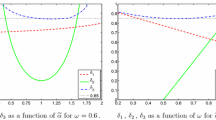Abstract
This paper deals with nonoverlapping domain decomposition methods for two coupled Stokes flows, based on the duality theory. By introducing a fictitious variable in the transmission condition and using saddle-point equations, the problem is restated as a linearly constrained maximization problem. According to whether constraints are uncoupled Stokes problems or uncoupled Poisson problems, two Uzawa-type domain decomposition algorithms are proposed. The results of some numerical experiments on a model problem are given.
Similar content being viewed by others
References
Bernardi C., Chacon, T., Lewandowski R., and Murat F. (2002). A model for two coupled turbulent fluids I: Analysis of the system. Nonlinear Partial Differential Equations and Their Applications. Collège de France Seminar, Vol. XIV (Paris, 1997/1998), Stud. Math. Appl. 31, North-Holland, Amsterdam. pp. 69–102.
C. Bernardi T. Chacon R. Lewandowski F. Murat (2003) ArticleTitleA model for two coupled turbulent fluids II: Numerical analyslis of a spectral discretization SIAM J. Numer. Anal. 40 2368–2394 Occurrence Handle10.1137/S0036142901385829
C. Bernardi T. Chacón-Rebello Gomez-Mármol R. Lewandowski F. Murat (2004) ArticleTitleA model for two coupled turbulent fluids III: Numerical approximation by Finite elements Numer. Math. 98 33–66 Occurrence Handle10.1007/s00211-003-0490-9 Occurrence Handle2005g:76074
D. A. Bresch (2004) ArticleTitleA direct asymptotic analysis on a nonlinear model with thin layers Ann. Univ. Ferrara 7 359–373
D. Bresch J. Koko (2004) ArticleTitleAn optimization-based domain decomposition method for nonlinear wall laws in coupled systems Math. Models Methods Appl. Sci. 14 1085–1101 Occurrence Handle10.1142/S0218202504003556 Occurrence Handle2005i:65206
J. A. T. Bye J.-O. Wolff (2001) ArticleTitleQuasi-geostrophic modelling of the coupled ocean atmosphere Math. Comput. Modelling 33 609–617 Occurrence Handle10.1016/S0895-7177(00)00265-X
P.-G. Ciarlet (1979) The finite element method for elliptic problems North-Holland Amsterdam
J. Daniel (1970) The approximate minimization of functionals Prentice–Hall Englewood Cliffs, NJ
Q. Du (2001) ArticleTitleOptimization based non-overlapping domain decomposition algorithms and their convergence SIAM J. Numer. Anal. 39 1056–1077 Occurrence Handle1004.65132 Occurrence Handle2003b:65117
Q. Du M.D. Gunzburger (2000) ArticleTitleA gradient method approach to optimization-based multidisciplinary simulations and nonverlapping domain decomposition algorithms SIAM J. Numer. Anal. 37 1513–1541 Occurrence Handle2001d:65162
I. Ekeland R. Temam (1999) Convex Analysis and Variational Problems SIAM Philadelphia
R. Glowinski (2003) Numerical methods for fluids P. G. Ciarlet J. L. Lions (Eds) Handbook of Numerical Analysis North-Holland Amsterdam
R. Glowinski P. Le Tallec (1989) Augmented Lagrangian and Operator-splitting Methods in Nonlinear Mechanics SIAM Philadelphia
R. Glowinski A. Marocco (1975) ArticleTitleSur l’approximation par éléments finis d’ordre un, et la résolution par pénalisation–dualité, d’une classe de problèmes de Dirichlet nonlinéaires RAIRO Anal. Num. 2 41–76
M. D. Gunzburger H. K. Lee (2000) ArticleTitleAn optimization–based domain decomposition method for Navier–Stokes equations SIAM J. Numer. Anal. 37 1455–1480 Occurrence Handle2001d:65163
M.D. Gunzburger J. Peterson (1999) ArticleTitleAn optimization based domain decomposition method for partial differential equations Comp. Math. Appl. 37 77–93 Occurrence Handle10.1016/S0898-1221(99)00127-3 Occurrence Handle2000a:65159
J. Koko (2002) ArticleTitleAn optimization based domain decomposition method for a bonded structure Math. Models Meth. Appl. Sci. 12 857–870 Occurrence Handle10.1142/S0218202502001933 Occurrence Handle01882900 Occurrence Handle2003d:74009
Lewandowski, R. (1997). Analyse Mathématique et Océanographie, Collection “Recherche en Mathématiques Appliquées”, Masson.
J.-L. Lions R. Temam S. Wang (1993) ArticleTitleModels for the coupled atmosphere and ocean. (CAO I,II) Comput. Mech. Adv. 1 1–120 Occurrence Handle94m:35247
D. Luenberger (1989) Linear and Nonlinear Programming Addison Wesley Reading, MA
E. Miglio A. Quarteroni F. Saleri (2003) ArticleTitleCoupling of free-surface and groundwater flows Comput. Fluids 22 73–83
E. Polak (1971) Computational Methods in Optimisation Academic Press New York
P. M. Suquet (1988) Discontinuities and plasticity J. J. Moreau P. D. Panagiotopoulos (Eds) Nonsmooth Mechanics and Applications Springer New-York 279–340
A. Quarteroni A. Valli (1999) Domain Decomposition Methods for Partial Differential Equations Oxford University Press Oxford
Author information
Authors and Affiliations
Corresponding author
Rights and permissions
About this article
Cite this article
Koko, J. Uzawa Conjugate Gradient Domain Decomposition Methods for Coupled Stokes Flows. J Sci Comput 26, 195–216 (2006). https://doi.org/10.1007/s10915-005-4933-6
Received:
Accepted:
Published:
Issue Date:
DOI: https://doi.org/10.1007/s10915-005-4933-6




